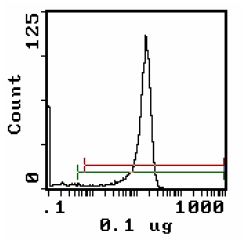Cd8b Mouse Monoclonal Antibody [Clone ID: 3.4.1]
Other products for "Cd8b"
Specifications
| Product Data | |
| Clone Name | 3.4.1 |
| Applications | FC |
| Recommended Dilution | Flow Cytometry, Immunoprecipitation and Western blotting. Test Results: Tissue Distribution by Flow Cytometry Analysis: Rat Strain: Wister. Cell Concentration: 1x10e6 cells per tests. Antibody Concentration Used: 0.5 μg/10e6 cells. Isotypic Control: Biotin Mouse IgG1. Cell Source : Percentage of cells stained above control: Thymus : 90.0% Spleen Cells : 15.2% Lymph Nodes : 17.0% |
| Reactivities | Rat |
| Host | Mouse |
| Isotype | IgG1 |
| Clonality | Monoclonal |
| Immunogen | Rat/mouse T cell hybrids expressing CD8. |
| Specificity | This monoclonal antibody reacts with the beta chain of the CD8 differentiation antigen. The 3.4.1 antibody also blocks both activation in an allogenic response and cell mediated cytotoxicity by CD8 T cells. |
| Formulation | PBS containing 0.02% Sodium Azide as preservative and EIA grade BSA as a stabilizing protein to bring total protein concentration to 4-5 mg/ml. Label: Biotin State: Liquid purified IgG fraction. |
| Concentration | 0.1 mg/ml |
| Purification | Protein G Chromatography of Ascites fluid. |
| Conjugation | Biotin |
| Gene Name | Rattus norvegicus CD8b molecule (Cd8b) |
| Database Link | |
| Background | CD8b is expressed on most thymocytes and mature T cytotoxic/suppressor cells (MHC class I restricted). While the CD8a and CD8b form a heterodimer on the surface of thymocytes and thymus-dependent T cytotoxic/suppressor cells, the majority of NK cells, many CD8 T cells from athymic rats, many activated CD4 T cells, and intestinal epithelium lymphocytes (IEL) express CD8a without CD8b. This suggests that expression of the CD8 heterodimer (a/b) is more dependant on intrathymic T cell maturation than that of the homodimer (a/a). The thymus dependence of CD8a/b T cells may be due to a requirement for thymic selection on self MHC class I antigens. |
| Synonyms | CD8B, CD8B1 |
| Note | Protocol: Flow Cytometry Analaysis: Method: 1. Prepare a cell suspension in media A. For cell peparations, deplete the red blood cell population with Lympholyte®-Rat cell separation medium. 2. Wash 2 times. 3. Resuspend the cells to a concentration of 2x10e7 cells/ml in media A. Add 50 μl of this suspension to each tube (each tube will then contain 1x10e6 cells, representing 1 test). 4. To each tube, add 50μl of a 1.0 µg* dilution of SM260B or SM260BX per 10e6 cells. 5. Vortex the tubes to ensure thorough mixing of antibody and cells. 6. Incubate the tubes for 30 minutes at 4°C. 7. Wash 2 times at 4°C. 8. Add 100 μl of secondary antibody PE Streptavidin at 1:500 dilution. 9. Incubate the tubes at 4°C for 30-60 minutes. (It is recommended that the tubes are protected from light since most fluorochromes are light sensitive). 10. Wash 2 times at 4°C in media B. 11. Resuspend the cell pellet in 50 μl ice cold media B. Transfer to suitable tubes for flow cytometric analysis containing 15 μl of propidium iodide at 0.5 mg/ml in PBS. This stains dead cells by intercalating in DNA. Media: A. Phosphate buffered saline (pH 7.2) + 5% normal serum of host species + sodium azide (100 μl of 2M sodium azide in 100 mls). B. Phosphate buffered saline (pH 7.2) + 0.5% Bovine serum albumin + sodium azide (100 μl of 2M sodium azide in 100 mls). |
| Reference Data | |
Documents
| Product Manuals |
| FAQs |
| SDS |
{0} Product Review(s)
0 Product Review(s)
Submit review
Be the first one to submit a review
Product Citations
*Delivery time may vary from web posted schedule. Occasional delays may occur due to unforeseen
complexities in the preparation of your product. International customers may expect an additional 1-2 weeks
in shipping.






























































































































































































































































 Germany
Germany
 Japan
Japan
 United Kingdom
United Kingdom
 China
China



